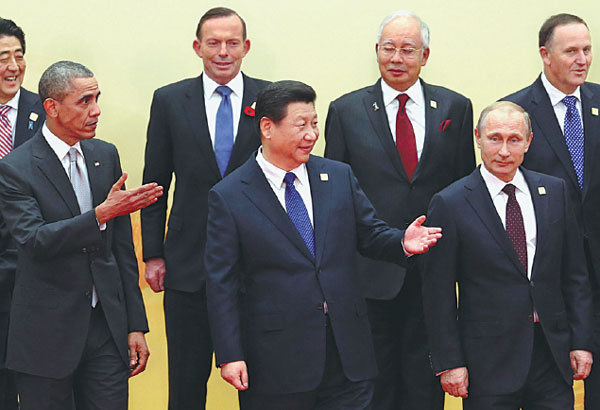APEC agrees to work on FTAAP
|
Leaders pose at the APEC meeting in Beijing on Tuesday. Pictured are President Xi Jinping (center, front), US President Barack Obama (left) and Russian President Vladimir Putin (right), and in the back are Japanese Prime Minister Shinzo Abe, Australian Prime Minister Tony Abbott, Malaysian Prime Minister Najib Razak and New Zealand Prime Minister John Key. Wu Zhiyi / China Daily |
Experts say different trade pacts in region are not mutually exclusive
In what Chinese President Xi Jinping called a "historic step", Asia-Pacific Economic Cooperation members agreed on Tuesday to launch an effort to build a regional free trade framework.
Leaders of the 21 member economies agreed in Beijing to start work on the Free Trade Area of the Asia-Pacific. Xi praised the agreement as a show of APEC's will to advance regional integration.
APEC member economies will begin studying issues surrounding the FTAAP and will submit recommendations by the end of 2016, according to a statement released after a two-day meeting of APEC leaders.
The FTAAP comes as the Washington-led Trans-Pacific Partnership trade negotiation has stalled due to disagreement between the US and Japan over agricultural tariffs.
China's goal is to "counter the growing trend of fragmentation in the region that directly undermines economic integration, not the TPP or any other specific free-trade agreement", said Tang Guoqiang, president of China National Committee for Pacific Economic Cooperation.
Xi said in his APEC speech that the FTAAP does not go against existing free trade arrangements and can be the aggregate of existing free trade arrangements to consolidate regional integration and define long-term goals.
Chinese experts said the free trade arrangements in the region are not mutually exclusive and they highlighted the leaders' desire to explore different means to achieve the goal of promoting trade and removing protectionism.
Fu Xiaolan, director of the Technology and Management for Development Center at University of Oxford, said APEC's Beijing road map for promoting the FTAAP will further strengthen free trade cooperation and competitiveness in Asia-Pacific. The collaboration among APEC members will prove beneficial for China's integration with the global trade system, Fu said.
Details of the FTAAP's implementation remain to be clarified, observers said.
"The Asia-Pacific region is a daunting concept and trying to understand it as a market with any degree of commonality is challenging," said Kerry Brown, executive director of the China Studies Center at the University of Sydney.
Brown said free trade agreements are the most predictable and best established means to link the domestic growth of each member with global growth.
"But this doesn't mean that the proposal to create a free trade zone across the Asia-Pacific region won't be a huge endeavor," he said. The creation of a free trade zone needs a more specific framework with which to unleash the potential of the region, which represents the largest and most dynamic regional economic group in the world, he said.
To use its financial strength to boost the APEC's role as a regional free trade booster, China has pledged a contribution of $10 million to APEC to support its "institutional development and capacity building".
Xi announced on Tuesday that the country will provide 1,500 training positions to developing members of APEC to enhance their trade and investment.
"We need to expand financial and technological support to the developing members so that we can take advantage of the diversified and complementary roles of each member to achieve common growth in the region," Xi said.
Zhang Chunyan in London contributed to the story.
Contact the writers at zhangyunbi@chinadaily.com.cn and lixiang@chinadaily.com.cn



















